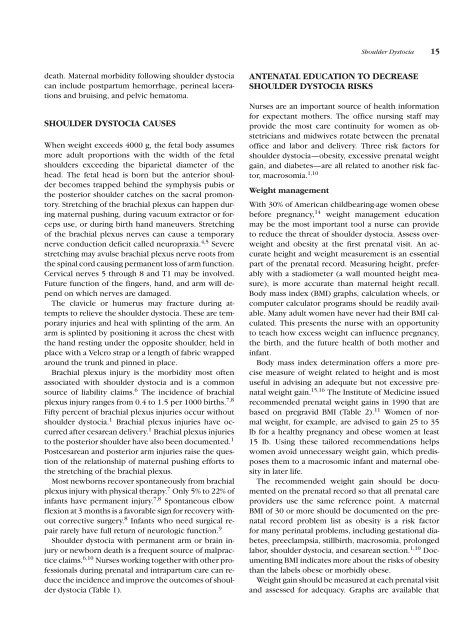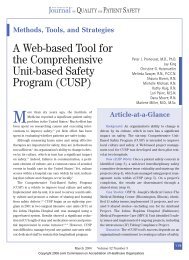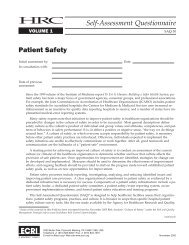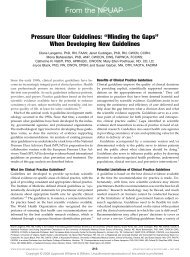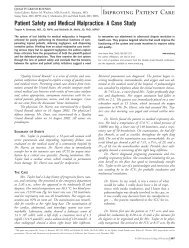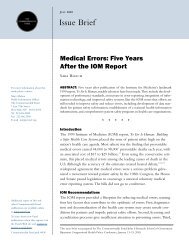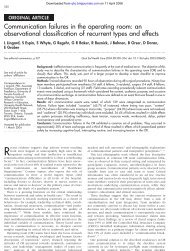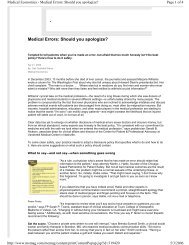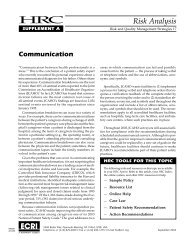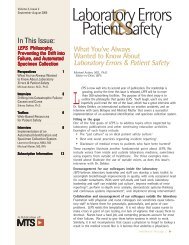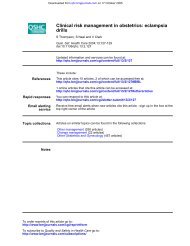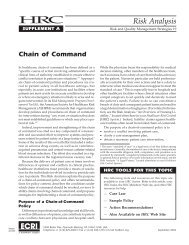Shoulder Dystocia - Lippincott Williams & Wilkins
Shoulder Dystocia - Lippincott Williams & Wilkins
Shoulder Dystocia - Lippincott Williams & Wilkins
You also want an ePaper? Increase the reach of your titles
YUMPU automatically turns print PDFs into web optimized ePapers that Google loves.
<strong>Shoulder</strong> <strong>Dystocia</strong> 15<br />
death. Maternal morbidity following shoulder dystocia<br />
can include postpartum hemorrhage, perineal lacerations<br />
and bruising, and pelvic hematoma.<br />
SHOULDER DYSTOCIA CAUSES<br />
When weight exceeds 4000 g, the fetal body assumes<br />
more adult proportions with the width of the fetal<br />
shoulders exceeding the biparietal diameter of the<br />
head. The fetal head is born but the anterior shoulder<br />
becomes trapped behind the symphysis pubis or<br />
the posterior shoulder catches on the sacral promontory.<br />
Stretching of the brachial plexus can happen during<br />
maternal pushing, during vacuum extractor or forceps<br />
use, or during birth hand maneuvers. Stretching<br />
of the brachial plexus nerves can cause a temporary<br />
nerve conduction deficit called neuropraxia. 4,5 Severe<br />
stretching may avulse brachial plexus nerve roots from<br />
the spinal cord causing permanent loss of arm function.<br />
Cervical nerves 5 through 8 and T1 may be involved.<br />
Future function of the fingers, hand, and arm will depend<br />
on which nerves are damaged.<br />
The clavicle or humerus may fracture during attempts<br />
to relieve the shoulder dystocia. These are temporary<br />
injuries and heal with splinting of the arm. An<br />
arm is splinted by positioning it across the chest with<br />
the hand resting under the opposite shoulder, held in<br />
place with a Velcro strap or a length of fabric wrapped<br />
around the trunk and pinned in place.<br />
Brachial plexus injury is the morbidity most often<br />
associated with shoulder dystocia and is a common<br />
source of liability claims. 6 The incidence of brachial<br />
plexus injury ranges from 0.4 to 1.5 per 1000 births. 7,8<br />
Fifty percent of brachial plexus injuries occur without<br />
shoulder dystocia. 1 Brachial plexus injuries have occurred<br />
after cesarean delivery. 1 Brachial plexus injuries<br />
to the posterior shoulder have also been documented. 1<br />
Postcesarean and posterior arm injuries raise the question<br />
of the relationship of maternal pushing efforts to<br />
the stretching of the brachial plexus.<br />
Most newborns recover spontaneously from brachial<br />
plexus injury with physical therapy. 7 Only 5% to 22% of<br />
infants have permanent injury. 7,8 Spontaneous elbow<br />
flexion at 3 months is a favorable sign for recovery without<br />
corrective surgery. 8 Infants who need surgical repair<br />
rarely have full return of neurologic function. 9<br />
<strong>Shoulder</strong> dystocia with permanent arm or brain injury<br />
or newborn death is a frequent source of malpractice<br />
claims. 6,10 Nurses working together with other professionals<br />
during prenatal and intrapartum care can reduce<br />
the incidence and improve the outcomes of shoulder<br />
dystocia (Table 1).<br />
ANTENATAL EDUCATION TO DECREASE<br />
SHOULDER DYSTOCIA RISKS<br />
Nurses are an important source of health information<br />
for expectant mothers. The office nursing staff may<br />
provide the most care continuity for women as obstetricians<br />
and midwives rotate between the prenatal<br />
office and labor and delivery. Three risk factors for<br />
shoulder dystocia—obesity, excessive prenatal weight<br />
gain, and diabetes—are all related to another risk factor,<br />
macrosomia. 1,10<br />
Weight management<br />
With 30% of American childbearing-age women obese<br />
before pregnancy, 14 weight management education<br />
may be the most important tool a nurse can provide<br />
to reduce the threat of shoulder dystocia. Assess overweight<br />
and obesity at the first prenatal visit. An accurate<br />
height and weight measurement is an essential<br />
part of the prenatal record. Measuring height, preferably<br />
with a stadiometer (a wall mounted height measure),<br />
is more accurate than maternal height recall.<br />
Body mass index (BMI) graphs, calculation wheels, or<br />
computer calculator programs should be readily available.<br />
Many adult women have never had their BMI calculated.<br />
This presents the nurse with an opportunity<br />
to teach how excess weight can influence pregnancy,<br />
the birth, and the future health of both mother and<br />
infant.<br />
Body mass index determination offers a more precise<br />
measure of weight related to height and is most<br />
useful in advising an adequate but not excessive prenatal<br />
weight gain. 15,16 The Institute of Medicine issued<br />
recommended prenatal weight gains in 1990 that are<br />
based on pregravid BMI (Table 2). 11 Women of normal<br />
weight, for example, are advised to gain 25 to 35<br />
lb for a healthy pregnancy and obese women at least<br />
15 lb. Using these tailored recommendations helps<br />
women avoid unnecessary weight gain, which predisposes<br />
them to a macrosomic infant and maternal obesity<br />
in later life.<br />
The recommended weight gain should be documented<br />
on the prenatal record so that all prenatal care<br />
providers use the same reference point. A maternal<br />
BMI of 30 or more should be documented on the prenatal<br />
record problem list as obesity is a risk factor<br />
for many perinatal problems, including gestational diabetes,<br />
preeclampsia, stillbirth, macrosomia, prolonged<br />
labor, shoulder dystocia, and cesarean section. 1,10 Documenting<br />
BMI indicates more about the risks of obesity<br />
than the labels obese or morbidly obese.<br />
Weight gain should be measured at each prenatal visit<br />
and assessed for adequacy. Graphs are available that


